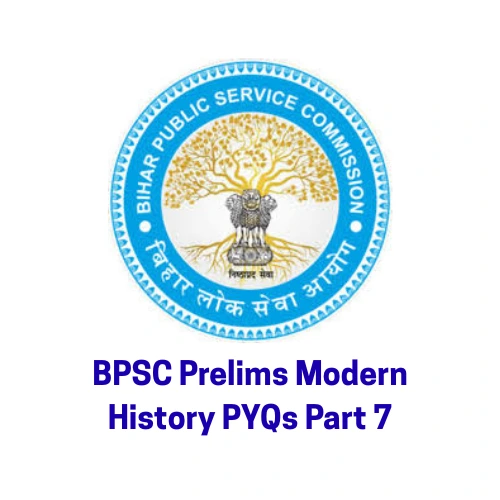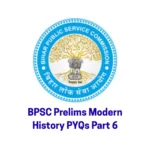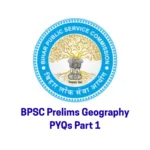BPSC Prelims Modern History PYQs Part 7 highlight the evolution of the Indian freedom struggle from early resistance to mass movements under Gandhi. The syllabus includes socio-religious reform movements, contributions of revolutionaries, major congress leaders, British legislations, and Bihar’s role in the independence struggle. A strong grasp of events, personalities, and timelines ensures accuracy in solving PYQs.
BPSC Prelims Modern History PYQs Part 7
Who raised the demand of “Complete Independence” for the first time in 1921?
(a) Maulana Mohammad Ali
(b) Pandit Jawaharlal Nehru
(c) Mahatma Gandhi
(d) Maulana Hasrat Mohani
Ans. (d)
Identify the years those are closest of the founding of the Communist Party of India and RSS respectively.
(a) 1914, 1915
(b) 1925, 1925
(c) 1928, 1925
(d) 1925, 1929
Ans. (b)
Which of the following events was the last to take place?
(a) The Harsha Charita
(b) The Partition of Bengal
(c) The Home Rule Movement
(d) The Lucknow Pact
(e) None of the above/More than one of the above
Ans. (c)
Who among the following founded the All-India Depressed Classes Federation in 1930?
(a) Mahatma Jyotiba Phule
(b) B.R. Ambedkar
(c) Periyar E.V. Ramaswami Naicker
(d) Acharya Narendra Dev
(e) None of the above/More than one of the above
Ans. (b)
Who was the editor of the “Indian Sociologist”?
(a) Shyamji Krishna Varma
(b) Lala Hardayal
(c) B.P. Pal
(d) V.D. Savarkar
(e) None of the above/More than one of the above
Ans. (a)
Modern History Questions and Answers
Who was the Viceroy when the Rowlatt Act was passed?
(a) Lord Hardinge II
(b) Lord Chelmsford
(c) Lord Reading
(d) Lord Willingdon
(e) None of the above/More than one of the above
Ans. (b)
Who was the first elected President of the Constituent Assembly?
(a) B.R. Ambedkar
(b) Dr. Sachchidananda Sinha
(c) Dr. Rajendra Prasad
(d) S. Radhakrishnan
(e) None of the above/More than one of the above
Ans. (c)
Where was the first session of the Indian National Congress held?
(a) Calcutta
(c) Madras
(b) Delhi
(d) Bombay
(e) None of the above/More than one of the above
Ans. (d)
Who founded the British Committee of the Indian National Congress?
(a) A.O. Hume
(c) Dadabhai Naoroji
(b) William Wedderburn
(d) W.C. Bonnerjee
(e) None of the above/More than one of the above
Ans. (b)
Who among the following was the founder of the Indian Association?
(a) A.O. Hume
(b) Dadabhai Naoroji
(c) S.N. Banerjee
(d) W.C. Bonnerjee
(e) None of the above/More than one of the above
Ans. (c)
Modern History Questions and Answers
Who among the following founded the Indian National Social Conference?
(a) Surendra Nath Banerjee
(b) Bal Gangadhar Tilak
(c) B.M. Malabari
(d) M.G. Ranade
(e) None of the above/More than one of the above
Ans. (d)
Which party founded the ‘Independence for India League’ in 1928?
(a) Indian National Congress
(b) Kisan Sabha
(c) Communist Party of India
(d) None of the above/More than one of the above
Ans. (a)
Who among the following had demanded the imposition of President’s Rule in Madras in 1948?
(a) P.S. Kumaraswami Raja
(b) O.P. Ramaswami Reddiar
(c) A.K. Gopalan
(d) B. C. Roy
(e) None of the above/More than one of the above
Ans. (c)
The author of the book “India Divided” is
(a) Pandit Jawaharlal Nehru
(c) Sardar Vallabhbhai Patel
(b) Dr. Rajendra Prasad
(d) Maulana Abul Kalam Azad
(e) None of the above/More than one of the above
Ans. (b)
Which Governor-General had abolished slavery?
(a) Lord Ellenborough
(b) Lord William Bentinck
(c) Sir John Shore
(d) Lord Auckland
(e) None of the above/More than one of the above
Ans. (a)
BPSC Prelims Modern History PYQs Part 7
Who among the following was associated with the formation of the ‘Raiyotwari System’?
(a) Cornwallis
(c) Elphinstone
(b) Munro
(d) Malcolm
(e) None of the above/More than one of the above
Ans. (b)
Which Governor-General of India was called the ‘Liberator of the Indian Press’?
(a) Lord Curzon
(b) Sir Charles Metcalfe
(c) Lord Wellesley
(d) Lord William Bentinck
(e) None of the above/More than one of the above
Ans. (b)
Who among the following was the leader of the Santhal revolt?
(a) Birsa Munda
(c) Sidhu and Kanho
(b) Swami Sahajanand
(d) Shambhudan
(e) None of the above/More than one of the above
Ans. (c)
When did the Bardoli Satyagraha take place?
(a) 1925
(c) 1929
(b) 1928
(d) 1930
(e) None of the above/More than one of the above
Ans. (b)
The ‘Do or Die’ slogan is associated with which one of the movements?
(a) Civil Disobedience Movement
(b) Non-Cooperation Movement
(c) Quit India Movement
(d) Khilafat Movement
(e) None of the above/More than one of the above
Ans. (c)
Modern History Questions and Answers
Who was the first person to use the word “Adivasi” to refer to the tribal people?
(a) Mahatma Gandhi
(b) Thakkar Bappa
(c) B.R. Ambedkar
(d) Jyotiba Phule
(e) None of the above/More than one of the above
Ans. (b)
The main objective of the Indian National Congress in 1939 was
(a) Complete independence
(b) Dominion status
(c) Responsible government
(d) Participation of the Indian people in the war
Ans. (a)
Who was the first Muslim President of the Indian National Congress?
(a) Abul Kalam Azad
(b) Badruddin Tyabji
(c) Syed Ahmad Khan
(d) Muhammad Ali Jinnah
(e) None of the above/More than one of the above
Ans. (b)
Who was the Viceroy of India at the time of the formation of the Indian National Congress?
(a) Lord Dufferin
(b) Lord Ripon
(c) Lord Canning
(d) Lord Mayo
(e) None of the above/More than one of the above
Ans. (a)
“Swadeshi Movement” was started in India during
(a) Anti-Bengal Partition Agitation
(b) Champaran Satyagraha
(c) Non-Cooperation Movement
(d) Anti-Rowlatt Act Satyagraha
(e) None of the above/More than one of the above
Ans. (a)
BPSC Prelims Modern History PYQs Part 7
Who was the chairman of the Drafting Committee of the Indian Constitution?
(a) Sardar Patel
(b) Dr. B.R. Ambedkar
(c) Rajendra Prasad
(d) Jawahar Lal Nehru
Ans. (b)
Who among the following leaders suggested the winding up of the Indian National Congress after India attained independence?
(a) C. Rajagopalachari
(b) Mahatma Gandhi
(c) Jawaharlal Nehru
(d) Subhash Chandra Bose
Ans. (b)
Who said that “the only reason for the British to hold India is the ultimate profit”?
(a) Subhash Chandra Bose
(b) Lala Lajpat Rai
(c) Dadabhai Naoroji
(d) Mahatma Gandhi
Ans. (c)
Which of the following institutions was not founded by Mahatma Gandhi?
(a) Phoenix Ashram
(b) Vishwa Bharati
(c) Sabarmati Ashram
(d) Sewagram Ashram
Ans. (b)
The first tribal leader who was inspired by Mahatma Gandhi was
(a) Alluri Sitarama Raju
(b) Jadonang
(c) Rani Gaidinliu
(d) Rupchand
Ans. (b)
Modern History Questions and Answers
Who coined the word “Pakistan”?
(a) Muhammad Ali Jinnah
(b) Choudhry Rahmat Ali
(c) Fazlul Haq
(d) Liaqat Ali Khan
Ans. (b)
When was the Partition of Bengal cancelled?
(a) 1905
(c) 1911
(b) 1907
(d) 1913
(e) None of the above/More than one of the above
Ans. (c)
The ‘Hindustan Socialist Republic Association’ was established in the year
(a) 1925
(b) 1928
(c) 1929
(d) 1930
(e) None of the above/More than one of the above
Ans. (b)
What was the ultimate aim of the Non-Cooperation Movement?
(a) Purna Swaraj for India
(b) Betterment of the peasants
(c) Removal of the British government
(d) None of the above/More than one of the above
Ans. (d)
Who was the leader of the ‘Waqf-i-Am’ organization?
(a) Shaukat Ali
(b) Abul Kalam Azad
(c) Mohammed Ali Jinnah
(d) None of the above/More than one of the above
Ans. (c)
BPSC Prelims Modern History PYQs Part 7
Who founded the ‘All India Kisan Sabha’ in 1936?
(a) N. G. Ranga
(b) Swami Sahajanand Saraswati
(c) Abdul Aziz
(d) S. C. Joshi
(e) None of the above/More than one of the above
Ans. (b)
The revolt of 1857 at Lucknow was led by
(a) Begum of Awadh
(b) Tantia Tope
(c) Rani Lakshmibai
(d) Nana Saheb
Ans. (a)
When was the Rowlatt Act passed?
(a) 1919
(b) 1920
(c) 1921
(d) 1922
Ans. (a)


